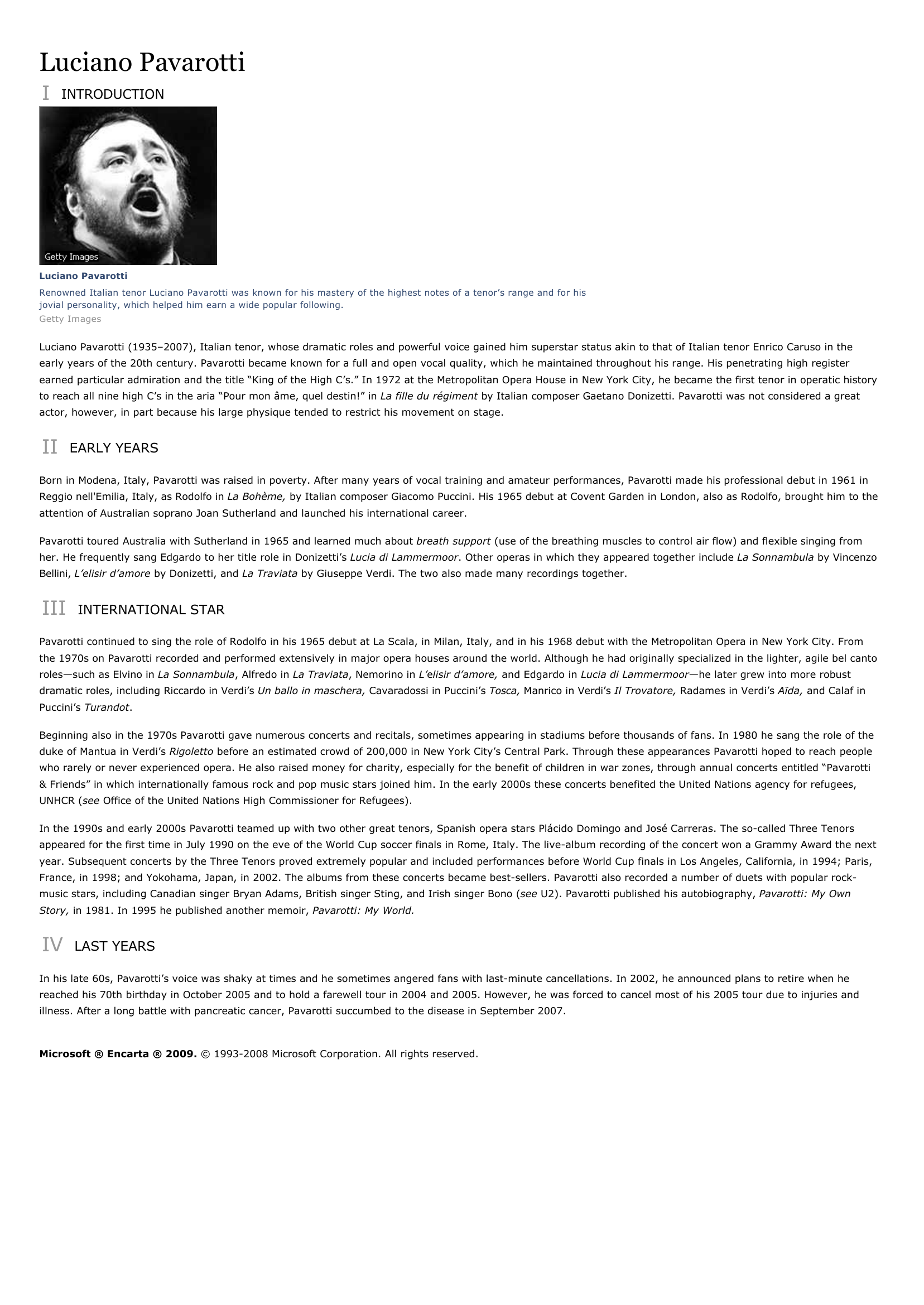Pavarotti Luciano
Publié le 06/04/2019

Extrait du document
«
Powered by TCPDF (www.tcpdf.org)Luciano Pavarotti
I INTRODUCTION
Luciano PavarottiRenowned Italian tenor Luciano Pavarotti was known for his mastery of the highest notes of a tenor’s range and for hisjovial personality, which helped him earn a wide popular following.Getty Images
Luciano Pavarotti (1935–2007), Italian tenor, whose dramatic roles and powerful voice gained him superstar status akin to that of Italian tenor Enrico Caruso in the early years of the 20th century.
Pavarotti became known for a full and open vocal quality, which he maintained throughout his range.
His penetrating high registerearned particular admiration and the title “King of the High C’s.” In 1972 at the Metropolitan Opera House in New York City, he became the first tenor in operatic historyto reach all nine high C’s in the aria “Pour mon âme, quel destin!” in La fille du régiment by Italian composer Gaetano Donizetti.
Pavarotti was not considered a great actor, however, in part because his large physique tended to restrict his movement on stage.
II EARLY YEARS
Born in Modena, Italy, Pavarotti was raised in poverty.
After many years of vocal training and amateur performances, Pavarotti made his professional debut in 1961 inReggio nell'Emilia, Italy, as Rodolfo in La Bohème, by Italian composer Giacomo Puccini.
His 1965 debut at Covent Garden in London, also as Rodolfo, brought him to the attention of Australian soprano Joan Sutherland and launched his international career.
Pavarotti toured Australia with Sutherland in 1965 and learned much about breath support (use of the breathing muscles to control air flow) and flexible singing from her.
He frequently sang Edgardo to her title role in Donizetti’s Lucia di Lammermoor .
Other operas in which they appeared together include La Sonnambula by Vincenzo Bellini, L’elisir d’amore by Donizetti, and La Traviata by Giuseppe Verdi.
The two also made many recordings together.
III INTERNATIONAL STAR
Pavarotti continued to sing the role of Rodolfo in his 1965 debut at La Scala, in Milan, Italy, and in his 1968 debut with the Metropolitan Opera in New York City.
Fromthe 1970s on Pavarotti recorded and performed extensively in major opera houses around the world.
Although he had originally specialized in the lighter, agile bel cantoroles—such as Elvino in La Sonnambula , Alfredo in La Traviata , Nemorino in L’elisir d’amore, and Edgardo in Lucia di Lammermoor —he later grew into more robust dramatic roles, including Riccardo in Verdi’s Un ballo in maschera, Cavaradossi in Puccini’s Tosca, Manrico in Verdi’s Il Trovatore, Radames in Verdi’s Aïda, and Calaf in Puccini’s Turandot .
Beginning also in the 1970s Pavarotti gave numerous concerts and recitals, sometimes appearing in stadiums before thousands of fans.
In 1980 he sang the role of theduke of Mantua in Verdi’s Rigoletto before an estimated crowd of 200,000 in New York City’s Central Park.
Through these appearances Pavarotti hoped to reach people who rarely or never experienced opera.
He also raised money for charity, especially for the benefit of children in war zones, through annual concerts entitled “Pavarotti& Friends” in which internationally famous rock and pop music stars joined him.
In the early 2000s these concerts benefited the United Nations agency for refugees,UNHCR ( see Office of the United Nations High Commissioner for Refugees).
In the 1990s and early 2000s Pavarotti teamed up with two other great tenors, Spanish opera stars Plácido Domingo and José Carreras.
The so-called Three Tenorsappeared for the first time in July 1990 on the eve of the World Cup soccer finals in Rome, Italy.
The live-album recording of the concert won a Grammy Award the nextyear.
Subsequent concerts by the Three Tenors proved extremely popular and included performances before World Cup finals in Los Angeles, California, in 1994; Paris,France, in 1998; and Yokohama, Japan, in 2002.
The albums from these concerts became best-sellers.
Pavarotti also recorded a number of duets with popular rock-music stars, including Canadian singer Bryan Adams, British singer Sting, and Irish singer Bono ( see U2).
Pavarotti published his autobiography, Pavarotti: My Own Story, in 1981.
In 1995 he published another memoir, Pavarotti: My World.
IV LAST YEARS
In his late 60s, Pavarotti’s voice was shaky at times and he sometimes angered fans with last-minute cancellations.
In 2002, he announced plans to retire when hereached his 70th birthday in October 2005 and to hold a farewell tour in 2004 and 2005.
However, he was forced to cancel most of his 2005 tour due to injuries andillness.
After a long battle with pancreatic cancer, Pavarotti succumbed to the disease in September 2007.
Microsoft ® Encarta ® 2009. © 1993-2008 Microsoft Corporation.
All rights reserved..
»
↓↓↓ APERÇU DU DOCUMENT ↓↓↓
Liens utiles
- LUCIANO PAVAROTTI
- Pavarotti Luciano, né en 1935 à Modène, artiste lyrique italien.
- Pavarotti, Luciano - musique.
- Luciano PavarottiIINTRODUCTIONLuciano PavarottiRenowned Italian tenor Luciano Pavarotti was known for his mastery of the highest notes of a tenor's range and for hisjovial personality, which helped him earn a wide popular following.
- Luciano Pavarotti.

































